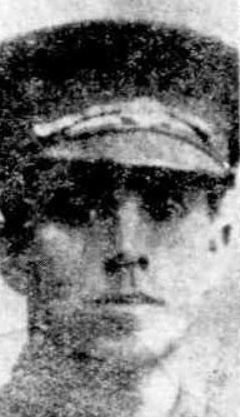John Thomas Buckland
From Our Contribution
 Sunday Times 26 Aug 1917 page 6S | |
| Personal Information | |
|---|---|
| Date of Birth |
not known "not known" contains an extrinsic dash or other characters that are invalid for a date interpretation. |
| Place of Birth | Jarrahdale, Western Australia |
| Death | 12 Mar 1954 |
| Place of Death | Rivervale, Western Australia |
| Age at Enlistment | 25 years, 4 months |
| Description |
5'3" (1.60 m) tall ; 125 lbs 56.699 kg ; fresh complexion ; brown eyes ; dark brown hair |
| Occupation | Timber faller |
| Religion | Methodist |
| Address | Jarrahdale, Western Australia |
| Next of Kin | Father , Mr Harry Buckland |
| Military Information | |
| Reg Number | 800 |
| Date of Enlistment |
25 Jan 1916 3 Jun 1916 |
| Rank | Private |
| Unit/Formation | 44th Battalion, D Company transferred to AAMC. |
| Date of Embarkation | 6 Jun 1916 ‒ 21 Jul 1916 |
| Ship Embarked On | HMAT A29 Suevic |
| Date of Return | 20 Aug 1918 ‒ 28 Sep 1918 |
| Ship Returned On | SS Carpentaria |
| Fate |
Wounded in Action 25 Jun 1917 (Shell shock) Returned to Australia |
| Monument |
Jarrahdale Honour Roll Gosnells Road Board Honour Roll Gosnells Ward Honour Roll |
| Medals |
British War Medal Victory Medal |
Contents
[hide]Pre War
War Service
Original enlistment on 25 Jan 1916 ceased before he left Australia, with him allocated to the Australian Army Medical Corp (AAMC) on 12 Feb 1916. His discharge date and the reason are unknown. However, he re-enlisted on 3 Jun 1916, and was allocated to the 44th Battalion as it was preparing to leave for England. Three days later he boarded HMAT A29 Suevic in Fremantle for Plymouth. Disembarking there on 21 Jun 1916.
The 44th Battalion undertook its training at Larkhill before travelling to France from Southampton on 25 Nov 1916. (John had spent from 7 until 11 Nov 1916 in hospital with pleurisy, rejoining his battalion on 11 Nov 1916.)
Initially his records record him as having been admitted to the 11th Casualty Clearing Station with debility on 29 Jun 1917. This was later changed to Wounded in Action 25 Jun 1917 with shell shock, so it appears to have been delayed reaction, or he had tried to 'soldier on'. The enemy had fired heavily on the battalion's supports and communication trenches on the 25th using high explosive, shrapnel, and gas shells. While no details are given it was not uncommon for men to be buried alive and then dug out in time to survive. Seen by a Field Ambulance he was not passed to the 11th Casualty Clearing Station until 29 Jun 1916, and then the 6th Canadian Stationary Hospital on 1 Jul 1917. Four days later he was moved to the 4th Stationary Hospital in Arques. Diagnosed with Shell shock "W", at the 32nd Stationary Hospital in Wimbrent on 2 Aug 1917 he was embarked on HMHS St Denis and in England admitted to the 4th London General Hospital. Transfer to the 1st Australian Auxiliary Hospital at Harefield followed on 21 Aug 1917 before he was given leave from 17 Sep - 1 Oct 1917.
Following his leave he was attached for duty to the 1st Australian Auxiliary Hospital from 1 Oct to 12 Nov 1917. For a few weeks he was transferred to the AAMC Details unit, but was again admitted to 1st Australian Auxiliary Hospital on 27 Dec 1917 with bronchitis for 4 days. Fit for duty again, he moved on 24 Jan 1918 to No 4 Command Depot in Hurdcott having been 'boarded' C2 and marked for return to Australia. However, another seven months was to pass before he began the return journey. On 27 May 1918 he was transferred to the No. 2 Command Depot at Weymouth where he remained until his return to Australia, marked as having 'faulty vision'. John was discharged by the 5th Military District on 30 Oct 1918.
Post War
Notes